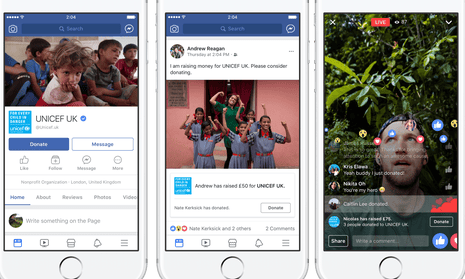Social media giant Facebook is to introduce tools to enable its members in UK and Europe to donate directly to selected charities.
The facility has been available in the US since 2015, and Facebook says it has made it easy to people to raise millions of dollars for charities, including more than $10m raised to help people affected by Hurricane Harvey.
Until now, it hasn’t been possible to donate money directly on Facebook itself in the UK or Europe. Instead, users are directed to a third party, such as JustGiving.
From the end of September, charities in five European countries, the UK, Ireland, France, Germany and Spain, will be able to work with Facebook to test the fundraising tools, including a direct donate button on their Facebook pages and posts to collect money without followers having to leave the website.
From early October, Facebook will expand the test rollout to Italy, Poland, the Netherlands, Belgium, Sweden, Portugal, Denmark, Austria, Finland and Luxembourg. To apply in the UK, organisations must be a registered UK charity, and will be verified by Facebook. That screening process opens on 12 September, with charities in all 16 countries able to apply for verification, which will involve them submitting additional financial and other information to Facebook. The company has not yet confirmed how many charities it will allow to access the donate tools.
Facebook also plans to prompt individuals to increase their donations. Two weeks before someone’s birthday, they will be asked if they want to set up a donation button, for one of the charities chosen by Facebook.
Direct donations will also be taken via Facebook Live events. Anita Yuen, Strategic Partner Manager at Facebook, said that collecting donations during a live broadcast has already become a powerful tool for fundraising. Ariana Grande’s benefit concert on 4 June, to honour victims of the Manchester terror attack, used donate buttons in Facebook Live to raise more than $450,000, she said.
Other fundraising organisations, such as JustGiving, may see the launch as encroaching on their territory, but Yuen said Facebook was not looking at any other organisations as competitors. “We just see this as a way to increase the opportunity for people to donate to good causes,” she said.
In the US, Facebook charges non-profit organisations a 5% fee, with 2% going towards the cost of vetting the organisations, fraud protection, operational costs and payment support. The remaining 3% covers payment processing. The cost breakdown will be slightly different for European and UK charities, which will pay a 5% fee on each donation: 3.5% to cover costs and 1.5% for payment processing.
JustGiving makes a 5% charge on donations, plus a monthly fee for charities. Some other platforms do not make a charge, including BT MyDonate. Natalie Waugh, head of MyDonate, welcomed Facebook’s decision to use its reach to encourage more people in the UK to donate to good causes. But she said the company needed to be transparent about its charges from the outset, so donors and charities could make informed decisions. “There’s nothing wrong with making a charge per se, but there are other companies, like us, that absorb those costs,” commented Waugh. “There does need to be more of a level playing field, so donors can be sure the money reaches those good causes rather than going into Facebook’s profits.”
Last year, Katherine Woo, product manager for Facebook’s social good team, said the idea was conceived during the height of the ice bucket challenge craze: “I was tagged by a friend to make my own video,” she explains. “And I said ‘ok, I’m ready to donate … where do I donate?’ But my friend didn’t know. Our team thought that if we could create a simple way to donate on Facebook, it would be a lot easier and you’d end up collecting more money.”
Talk to us on Twitter via @Gdnvoluntary and join our community for your free fortnightly Guardian Voluntary Sector newsletter, with analysis and opinion sent direct to you on the first Thursday of the month.
Looking for a role in the not-for-profit sector, or need to recruit staff? Take a look at Guardian Jobs.

Comments (…)
Sign in or create your Guardian account to join the discussion